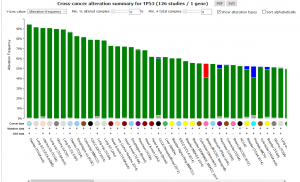Twitter told me OSA, AACR, and NCI retweeted Biden this morning about the cancer moonshot.
I put up an idea, “Engineering Virus Targeting Cells with TP53 dysfunction” that I wanted further describe here. If this is of interest to you, or you have expertise, please comment on it with that moonshot post. You can login to that site with social media accounts, I used twitter.
In taking cancer biology few years back, among other onco & tumor suppressor genes, I learned about a gene called TP53. This tumor suppressor gene said to be mutated in between 50-100% of all cancers. cBioportal.org confirms this and can provide you with mutational data from multiple genetic studies. If you type in tp53 this bears out in the results

Even if this is overstated and it’s 50% it seems to be important. My idea there is to design a virus that attacks cells with mutations to TP53. A properly designed virus will be destroyed by healthy cells with a functional TP53 pathway while unhealthy cells with dysfunctional TP53 will allow the virus to replicate.
The Idea
The idea is to use Cre-Lox recombination to make this virus this. Cre-Lox is a recombination technology similar to crisper. Use TP53 as the activator of Cre. As in Cre will only be transcribed in cells with functional TP53. Then put lox positions in the virus such that Cre activation destroys it. Then only cells that have a functional TP53 transcript can destroy the virus. The virus will also transcribe genes activating the apoptotic pathway under an strong promoter. Ideas there bax, or caspases. Strong promoters might be those of Actin or those in other viruses like SV40.
Here is my blueprint of this virus.

Anyways, a lot to work out there. There has been some similar work done. It is called Onyx-015. There the HPV virus was mutated to obtain a similar goal. The HPV virus is thought to cause cancer partially though inhibition of TP53 thought he protein E6.
More Background:
TP53 is a transcription factor. It transcribes genes that put an halt on mitosis. Many viruses inhibit TP53 in order to take over the cellular machinery and replicate.
TP53 tetramerizes, as in 4 sub protein units come together upon its activation. Units cane come transcripts from one of 2 copies each person has. Mutations to just one of these alles can lead to this gene to fail to tetramerize and active. Mutations are most likely found in the DNA binding and tetramerization domains of the protein.
Many oncogenes lead to the tetramerization of TP53. Under normal conditions, TP53 then suppresses growth in these cells to prevent cell proliferation. Hence it is a tumor suppressor gene.